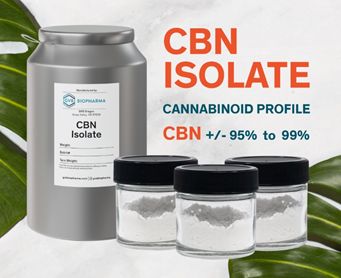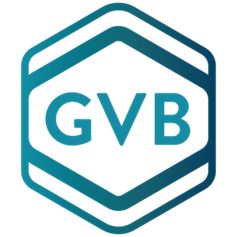The more that we learn about Cannabis sativa, the more fascinating this medicinal plant becomes. For years, THC was the only cannabinoid widely available on the market, and then CBD came along. In the wake of the CBD revolution, other non-intoxicating cannabinoids have come to the fore, and both CBG and CBN are now starting to make waves in cannabis markets around the world. The Future of The Hemp Industry: CBG vs. CBN
Industry leaders like GVB Biopharma, take pride in their status as one of the world’s only at-scale providers of high-quality, lab-tested CBG and CBN products. In this guide, learn what these cannabinoids are, which types of products they’re suited for, and why you should partner with trustworthy cannabinoid suppliers when adding emerging cannabinoids like CBG and CBN to your product offerings. The Future of The Hemp Industry: CBG vs. CBN
What is CBG?

Cannabigerol (CBG) is a chemical constituent of Cannabis sativa that is usually only expressed in very small concentrations. Via selective breeding, however, CBG-dominant Cannabis sativa strains have been developed, and some CBG-rich strains contain upward of 15% of this coveted cannabinoid.
The precursor of CBG, cannabigerolic acid (CBGa), can also transform into CBD, THC, or other cannabinoids when exposed to the right stimuli. Therefore, CBG is currently the subject of intensive inquiry within the field of cannabis science, and CBGa is commonly used to make at-scale quantities of rare cannabinoids such as cannabichromene (CBC).
CBG is highly similar to cannabidiol (CBD) both in its chemical structure and effects, but there are some key differences between these two non-intoxicating Cannabis sativa compounds. While CBG is currently being investigated for its potential digestion-boosting and antibacterial qualities, for instance, CBD does not appear to provide either of these benefits.
In exchange, cannabigerol might offer less affinity for the TRPV1 and 5-HT1A receptors, the primary targets of cannabidiol within the human nervous system. At this stage there is still much to learn about CBG, which is why GVB Biopharma recently embarked on a large-scale scientific endeavor to get to the bottom of CBG and its potential beneficial qualities. The world will know much more about CBG once this unprecedented research initiative is complete. The Future of The Hemp Industry: CBG vs. CBN
What is CBN?

Structurally, cannabinol (CBN) is actually more similar to THC than it is to CBD or any of the other non-intoxicating cannabinoids. This cannabinoid does not, however, have any intoxicating properties, and it might have unique benefits that set it apart from other chemical constituents of the Cannabis sativa plant.
While cannabinol has been studied since the 1940s, it’s only recently that the scientific community has taken significant interest in this cannabinoid. As a result, Cannabis sativa cultivars with high concentrations of CBN are not yet available, and instead, this cannabinoid is usually converted from CBD.
Cannabinol-rich products have become available on the market over the last couple of years, and initial anecdotal evidence indicates that many CBN users are experimenting with this cannabinoid extensively for sleep. At present, there isn’t enough scientific evidence to validate this potential benefit of CBN, but people continue using cannabinol for sleep regardless.
In addition to its possible sleep-inducing effects, CBN has also been investigated for its potential appetite benefits. THC is known to increase appetite but at the cost of potentially undesirable intoxicating and habit-forming properties. Since CBN is non-intoxicating, this cannabinoid may be shaping up as an alternative to THC for appetite stimulation.
CBG, CBN, and the entourage effect
Regardless of their individual benefits, CBN and CBG may be desirable purely for their potential contributions to the entourage effect, a theorized form of synergy that might occur when multiple cannabinoids are used in tandem. Scientists are starting to believe that cannabinoids offer additional benefits when they are ingested together, and if this is the case, adding CBN or CBG to CBD products may make them more effective.
Cannabis producers commonly capitalize on the entourage effect by offering “full-spectrum” or “broad-spectrum” extracts, which contain one highly concentrated cannabinoid alongside small concentrations of CBG, CBN, CBC, THCV, and other cannabis constituents commonly known as “minor” cannabinoids. If the entourage effect exists, however, it might be just as easy to invoke this synergistic phenomenon by combining isolated cannabinoid extracts. Putting isolate CBD, isolate CBN, and isolate CBG together in a single product may offer the same benefits as full-spectrum or broad-spectrum extract, or it might be even more beneficial.
Which product types are perfect for CBG?
CBG has a lot of properties that differentiate this cannabinoid from CBD, but during these times of heightened fear over infectious disease, cannabigerol has received extra attention for its potential antimicrobial properties. While antibacterial substances do not directly impact viral infections, cutting-edge research indicates that viruses may use bacteria in the process of infecting hosts, which is leading entrepreneurs to consider the validity of targeting CBG-infused topicals, oral products, and even vape pens toward the prevention of infectious diseases that are not caused by bacteria directly.
Since CBG has also received significant attention for its potential digestive benefits, this substance is commonly added to oral products that target your digestive system. Including other cannabinoids in CBG-infused products may increase the effectiveness of this Cannabis sativa compound due to the entourage effect.
Which product types are perfect for CBN?
CBN has also been researched for its potential antimicrobial qualities, but this theorized benefit has not received as much attention as this cannabinoid’s purported impact on sleep. Therefore, CBN is usually infused into products that are designed to facilitate sleep or treat insomnia, though this cannabinoid’s potential neuroprotective and appetite-inducing effects have also received significant attention recently.
Some hemp and cannabis users appreciate the convenience of vape pens for sleep, so including CBN in vape products might be a savvy move. Packaging CBN in tinctures, however, echoes this cannabinoid’s potential impact on appetite even though appetite is something that is modulated by the brain, not the gut. It may even be desirable to combine CBN with CBG in topical products that are designed to offer antimicrobial effects.
Why should you source your CBG & CBN from a reputable supplier?
While CBG has become relatively widely available over the last year or two, CBN is still extremely rare to find in bulk quantities. Using a proprietary conversion process, select suppliers like GVB Biopharma can produce high-purity CBN isolate in any bulk quantity, allowing entrepreneurs to capitalize on the emergence of an entirely new sector within the global cannabis economy. While smaller suppliers still struggle to offer high-purity CBG isolate that nears the caliber of their offerings, GVB also offers THC-free CBG distillate that is packed with terpenes, flavonoids, and trace concentrations of other cannabinoids.
GVB Biopharma can even offer CBG and CBN isolate or CBG distillate in water-soluble forms to make these extracts suitable for water-based product offerings. GVB exercises total control over their production process from seed to sale, testing their extracts at multiple stages of the production process. Their recent initiation of a wide-ranging scientific inquiry into the benefits and properties of CBG further demonstrates GVB’s commitment to this cannabinoid and the place CBG will take in the future of the global cannabis industry. The Future of The Hemp Industry: CBG vs. CBN

GVB Biopharma is a vertically integrated, global leader in the ever-growing hemp industry. We prioritize cannabinoid research, industry innovation, and traceable quality control. GVB operates two state-of-the-art facilities: a 30,000-square-foot food-grade hemp processing facility in Central Oregon and a 40,000-square-foot white-label consumer product manufacturing facility in Las Vegas.

